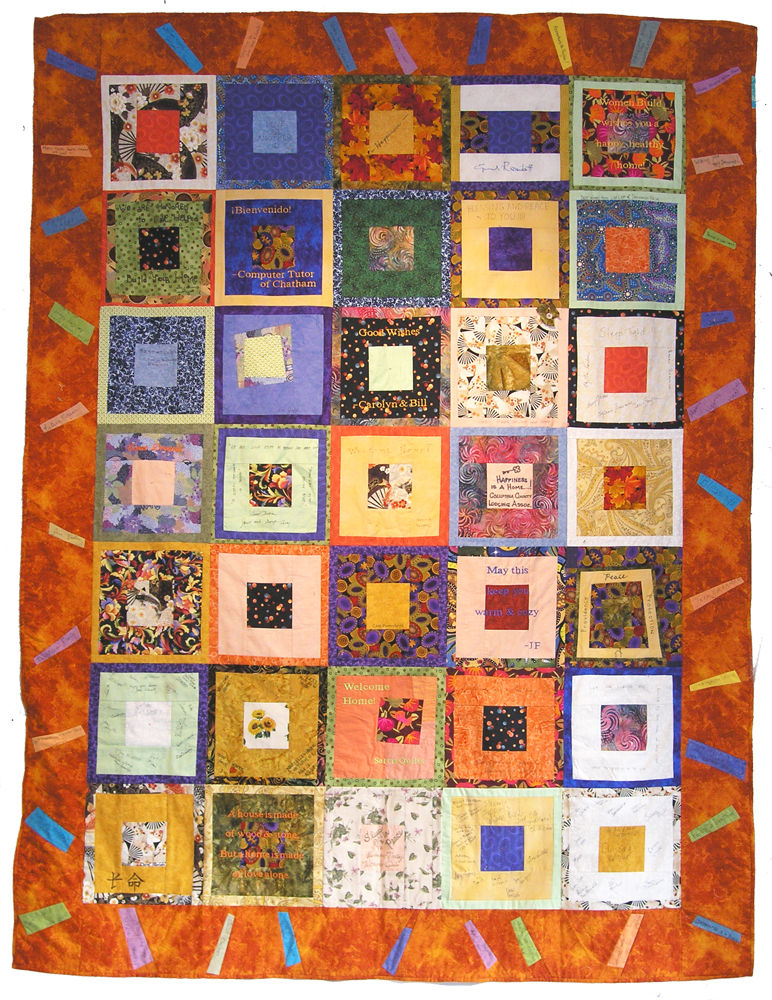Melissa Sarris
Sarris Quilts story and archive

Hand-dyed cottons, hand quilted. 91 x 110" This quilt was designed to represent and support my project Stitching Exchange - using sewing as a common language with immigrant communities.

Queen size quilt, hand dyed cottons, hand quilted.

Queen sized quilt hand dyed cotton hand quilted and hand embroidered.

Hand-dyed cottons, hand quilted. 91 x 110" This quilt was designed to represent and support my project Stitching Exchange - using sewing as a common language with immigrant communities.
Wall hangings

Wall hanging 29 x 31." Hand dyed cottons and hand quilted with thread and pearl cotton.

Wall hanging 30 x 50." Hand dyed cottons and hand quilted.

Wall hanging 20 x 60." Hand dyed cottons, silks and velvet. Hand quilted and mounted on stretchers.

Wall hanging 29 x 31." Hand dyed cottons and hand quilted with thread and pearl cotton.
I began Sarris Quilts more than 35 years ago with the desire to make something beautiful and functional for everyday use. I created my own designs that were influenced by the bold simplicity of Amish quilts with a contemporary flavor. Early on I began to work with hand dyed cottons and developed my hand quilting skills. Sustainable studio practices and sourced materials were intertwined into every project.
My work was displayed at prestigious craft venues across the country and in the collections of The Renwich Gallery in Washington, D.C., the People's Place Quilt Museum, and Cambridge Artist Cooperative, to name just a few.
After many years of designing, sewing and travel I was ready for a change. I had always planned on going to graduate school and finally the timing was right. But my intention was to broaden my textile practice. I learned to weld (more like sewing than you might think!) and work with three dimensional space.
Graduate school was tough, uncomfortable, and exactly what I was looking for. I became very excited by a new (to me) kind of art practice: Socially Engaged Art. Lately I have built up my own practice which I call a participatory and collaborative one.
There are still some interesting remnants from the Sarris Quilts work that cross over into my Socially Engaged projects. All those years attending crafts shows led to coming up with innovative ways to display the work that was portable and simple. And of course, talking to people.
Interested in a commissioned quilt? Contact me to see more images and to chat. I am also available for quilt repair. Please email me for more details.
Empathy Quilt, (pictured above,) is a recent work. It was made as a response to our world which seems to be less kind and less open everyday. The sale of this quilt will enable me to continue Stitching Exchange, a project I started working with immigrant women and two area learn to speak English organizations: RISSE and Hudson Family Literacy.
Follow us on instagram: @stichnexchange
Here are a few examples of works made specifically for the wall. Experimentation with size, scale and presentation are very interesting to me.
Community Engaged Works

Quilt 38 x 48." Recycled cotton shirts and jeans top stitched and hand tied.

Quilt 60 x 60." Hand dyed cottons with hand embroidery and hand tied. Blocks made by children in collaboration with my design to honor a beloved teacher.

Full sized quilt. Hand dyed cottons and prints. Machine embroidery, and hand tied. This quilt was made as both a fund raiser for my local Habitat for Humanity affiliate and as a gift to the new home owners.

Quilt 38 x 48." Recycled cotton shirts and jeans top stitched and hand tied.
These quilts were made in collaboration with various community groups. I have made quilts from baby clothes or from a beloved family member who has passed on. I have designed wedding quilts where family and friends of the couple contribue a block (where I have created a palette,) and then I have assembled them into a quilt.
This mode of working relates best to my art practice today and allows me to consider and draw from various aspects of the history of quilt making. Traditional quilt making was collaborative, especially when assembling and finishing the quilt. Fabircs were reused out of necessity, prompting ingenuity and innovative designs. The quilt was a common form for community building and even fund raising. These themes excite me and I would look forward to future opportunities of this kind.